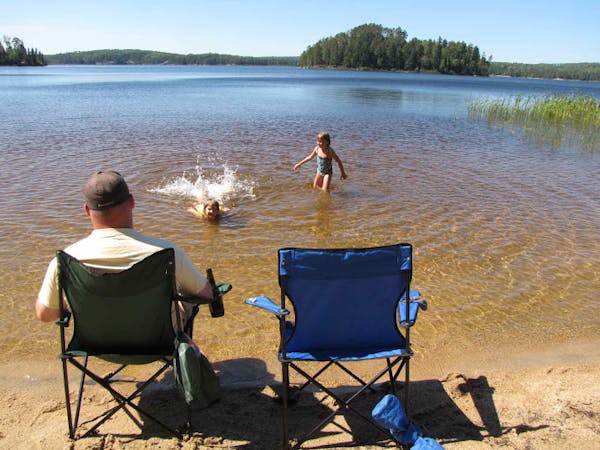The Twin Cities Canada goose population, once wildly out of control, might now be at its lowest level in decades.
That's good news for golfers, beach lovers, park users and others who don't appreciate stepping in fresh goose poop, but perhaps bad news for metro-area hunters, some of whom have noticed the declining numbers.
Tom Keefe of Cottage Grove, whose Canada Goose Management company removes problem geese from parks, golf courses, beaches and yards, has seen the decline first hand. Eight years ago, he took over a company that, in 1998, removed 7,500 problem geese from the Twin Cities.
"Last year, we removed about 600,'' he said — the second-lowest total since goose-removal efforts began in 1982. That number likely was especially small because the cold and wet spring weather hurt goose reproduction.
This spring, weather was better and so, too, was goose production.
"This year, we'll remove about 1,000,'' Keefe said. That's still less than half the number he removed as recently as 2010.
Thirty years of efforts to curb the metro area's Canada goose population through removal, harassment, egg destruction and other methods appear to have paid off. Since 1982, about 110,000 geese have been removed.
But the big birds remain ubiquitous, and their populations in the metro and elsewhere around the state are healthy.
"Believe me, there's no shortage of Canada geese in the Twin Cities,'' Keefe said.
And no one thinks geese won't continue to pose problems. A beach at Lake Calhoun was closed recently because of high levels of E. coli bacteria, likely from goose droppings.
"I don't think we've won the war, there's just a lull in the fighting,'' said John Moriarity, senior wildlife manager for Three Rivers Park District, which has battled geese for decades.
Three Rivers has employed Keefe's company in the past to round up problem geese but hasn't had to do that for several years. Instead, with federal and state permits, workers put vegetable oil on Canada goose eggs at two nesting sites, suffocating the embryos.
"The geese would just renest if we destroyed the nests,'' Moriarity said.
Population unknown
Though Twin Cities goose numbers appear to be down significantly, no one knows the actual population. The Department of Natural Resources conducts an aerial state survey each spring but doesn't include the Twin Cities because of cost and concerns of flying a helicopter at lower levels over the cities. This year, the state goose population was estimated at 250,000, similar to last year.
"The population has been high but stable over the last 15 years,'' said Steve Cordts, DNR waterfowl specialist.
But for the past 10 years, based on previous ground-based surveys, the DNR has estimated 17,500 breeding Canada geese are in the Twin Cities metro area. However, Keefe said, based on the numbers of geese he's seeing and capturing, the actual population probably is significantly less.
"It's definitely down,'' he said.
Keefe attributes the population decline to several factors: his goose-removal efforts, which remove both adult breeding birds and goslings; egg-oiling, which prevents eggs from hatching; and habitat changes, where landowners leave strips of tall grass near water, which discourages geese from coming ashore and fouling the area.
Fencing and harassment of geese with herding dogs also have encouraged geese to move elsewhere.
Geese are hunted in the greater metro area, and hunters there and elsewhere in the state have enjoyed liberal hunting seasons in recent years, including an August season established specifically to reduce Canada goose numbers.
"The liberal seasons probably have had an impact on the population, too,'' Keefe said.
The statewide goose harvest also has been down in recent years. Hunters killed about 229,000 in 2013, the second-lowest harvest in the past 12 years and nearly 100,000 fewer than they killed in 2006. Last year's harvest estimates haven't been reported yet by the DNR.
Cordts said that while metro geese provide some hunting opportunities, he's not concerned if the population there has dipped.
"I'd rather have fewer geese in the metro,'' he said, because of conflicts with humans. "And there are plenty of geese elsewhere. We're still harvesting 200,000 geese yearly.''
Meanwhile, Keefe and his crew recently removed geese from Theodore Wirth Golf Course and Loring Park in Minneapolis. Geese are removed from mid-June to mid-July, when adults are molting and can't fly, and goslings haven't developed their flight feathers.
The capture methods have remained the same over the years: Crews set up a pen, then herd the geese inside.
"We do a wild-goose chase,'' Keefe quipped.
The geese are taken to a holding facility, then sent to a processing facility. Adult geese are killed, processed and donated to local food shelves; goslings are killed and given to the Wildlife Science Center at Forest Lake, where they are fed to the wild animals.
Transporting the geese for release elsewhere, including other states, which was done in the early 1980s, no longer is an option. "No one wants more,'' Keefe said. Once rare, giant Canada geese now are common — and sometimes a nuisance — in many places.
The cost of removal? Keefe charges $1,500 per site, plus $16 processing per adult goose and $8 per gosling.
But with calls for geese removal down, and overhead and insurance costs steady, Keefe's part-time business isn't getting him rich.
"I'm at least breaking even this year,'' he said.
Doug Smith • dsmith@startribune.com
Twitter: @dougsmithstrib
Not every WNBA draft pick will make her team's roster. Here's why
![Twins fans cheer during their home opener against the Cleveland Guardians Thursday, April 4, 2024 at Target Field in Minneapolis. ] ANTHONY SOUFFLE �](https://arc.stimg.co/startribunemedia/OMOUFG3HLJENJIHGWSEYC5TUXY.jpg?h=91&w=145&fit=crop&bg=999&crop=faces)
